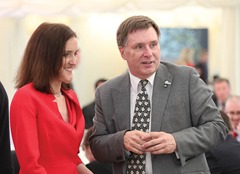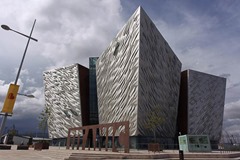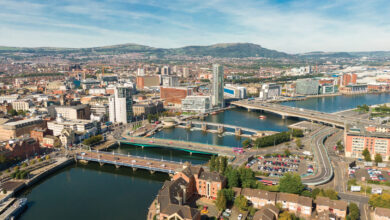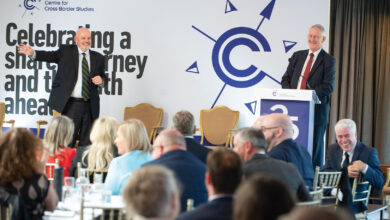Tourism 2020
 With 2012 changing the perception of Northern Ireland as a destination, Northern Ireland Tourist Board Chief Executive Alan Clarke talks to agendaNi about tourism’s contribution to the economy and plans to double the sector’s contribution by 2020 through a series of ‘game changers’.
With 2012 changing the perception of Northern Ireland as a destination, Northern Ireland Tourist Board Chief Executive Alan Clarke talks to agendaNi about tourism’s contribution to the economy and plans to double the sector’s contribution by 2020 through a series of ‘game changers’.
Tourism in Northern Ireland has become a vibrant part of the local economy, contributing 2.1 per cent (£534 million) and when the multiplier effect is included this rises to 4.9 per cent – which sustains over 40,000 jobs and is equivalent to the contribution made by the agriculture sector. There is much potential for increasing tourism’s contribution to the local economy when comparing Northern Ireland to similar countries such as Wales, where tourism is worth twice as much to the economy as in Northern Ireland.
“We want to double tourism by 2020, not in terms of visitors but in terms of spend. In order to achieve this ambitious target we have identified six ‘game changers’ for the sector. These game changers are grouped under four themes, with the first three focused on promotion,” says Alan Clarke.
Great Britain
Although the British market is the responsibility of Tourism Ireland, Clarke says: “Great Britain is on our doorstep and is a key market for us if we are going to grow tourism in the long term.” There has been a downward trend in visitor numbers to Northern Ireland since 2004 and for the Republic of Ireland the last three years have seen a dramatic reduction in the number of visitors from GB. To address falling visitors to the island from GB, a Tourism Recovery Taskforce was set up 18 months ago comprising Tourism Ireland, NITB, Fáilte Ireland and industry representatives. Going into the study 18 months ago the thinking was that Northern Ireland still had a perception problem and the Republic was thought to be poor value by potential GB visitors. The findings of the taskforce “were that the GB consumer would just rather go elsewhere, primarily Scotland. Scotland is really the big competition for us on the island of Ireland,” summarises Clarke.
Major events
The second game changer is around major events. Clarke says: “Our aspiration is to have at least one major global event in Northern Ireland every year.” To facilitate this NITB has put together an events strategy, which will see the establishment of a major events bidding group consisting of NITB, Belfast City Council, Derry City Council, the Arts Council and Sport NI “to work collaboratively and target what events we want to go for and also to decide which agency should take the lead on individual bids.”
Republic of Ireland
Although there has been a significant increase in the number of visitors from the Republic since 2004, Clarke believes that “we are really only scratching the surface of that market.” Although the number of visitors peaked in 2009 when exchange rates were most favourable for visitors from the Republic, the trend has continued upwards.
“For example, one third of all visitors coming to Titanic Belfast are from the south. I thought if we had achieved 10 to 15 per cent we would have done well, therefore 30 per cent is incredible. Part of the rationale of Titanic Belfast was to change visitor patterns and in that respect it has succeeded.”
Tourism business support
The fourth game-changer comes under the theme of ‘People & Business’ and is the creation of a more joined up approach by government agencies to support the private sector. This includes NITB, Invest NI and People First, the sector skills agency for the tourism and hospitality sector, which is largely funded by the Department for Employment and Learning (DEL). “It is about creating a one-stop-shop for tourism business support,” Clarke explains.
World class experiences
The fifth game-changer has the theme of ‘Product & Places’. NITB did some brand development work in 2009 and the “big idea” was ‘Northern Ireland moving on’. Clarke stresses this was not a campaign slogan “but more of a mind set. In developing the public realm buildings such as Titanic Belfast and the Causeway Visitor Centre we believed that they should reflect such a mind set.” The big theme within the branding was around ‘stories’ he adds.
“The brand is all about the emotion of stories such as Titanic, CS Lewis, Finn McCool and the Siege of Derry.” Clarke says that the issue for the Northern Ireland brand within the Ireland brand is about differentiation and “getting something to stand out.” He says that our stories make us stand out. This has led NITB to work closely with arts, heritage and cultural organisations much more closely. NITB now has a Memorandum of Understanding with the Arts Council, and last year it worked closely with the Environment Agency around heritage tourism and there are now plans to develop a number of innovative heritage projects such as Dunluce and Carrickfergus castles.
Rural tourism
Most of the growth in tourism in recent years in Northern Ireland has been in the two main cities. This has also been the trend across the UK and Ireland with most tourism growth in the cities. In terms of developing rural tourism, NITB was very much in favour of national parks but now recognises that it needs to think of other ways of driving rural tourism. Research has shown that many consumers want ‘City Plus’ holidays. “They might want to come to Belfast and want a day out of Belfast, largely activity-based. Northern Ireland has the advantage of being relatively compact and you can be in the Mournes in less than an hour from Belfast.”
These are six big ‘game changers’ that will drive tourism growth in Northern Ireland. In addition to these practical steps forward, Clarke asks the public and private sectors to look at what they are doing and to “apply a tourism lens to your activity”.
“We need to see how all programmes and spend can benefit the tourism sector, if tourism is going to be a key part of re-balancing the economy and we need a whole-of-government approach that values tourism to make this happen.”
650,000 visitors to Titanic Belfast
4.5m adults The reach ni 2012 of Our Time Our Place television advert on the island
130 countries The Causeway Visitor Centre opened in July and welcomed 320,000 visitors from 130 countries
130,000 The Irish Open attracted 130,000 spectators and was the European Tour’s first ever sell-out event
97% of attendees at the Clipper Homecoming agreed that it made them proud of their country Eight Belfast came 8th in TripAdvisor’s top 10 list of fastest growing travel destinations







